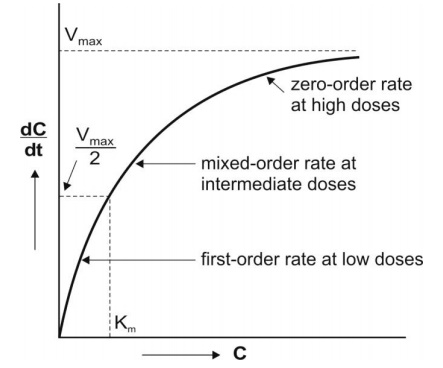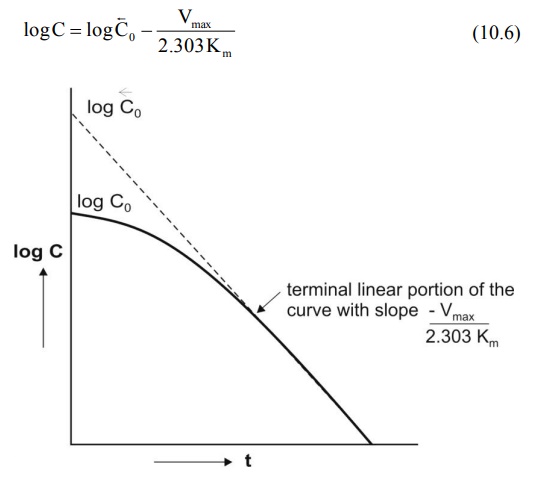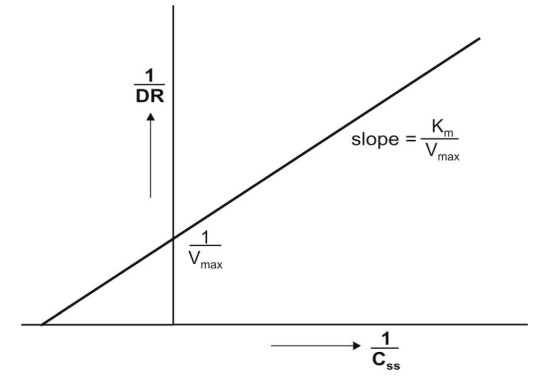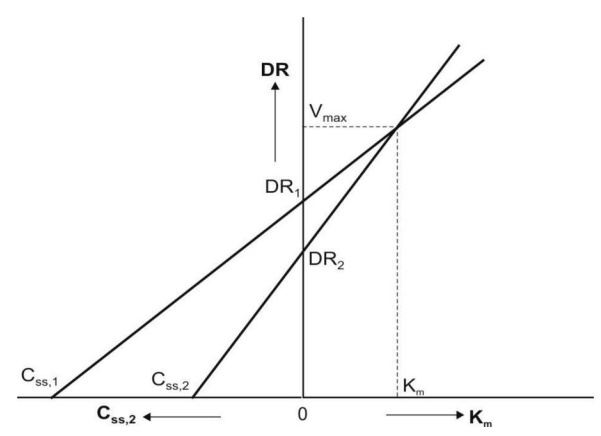NON-LINEAR PHARMACOKINETICS
Difference between Linear and non linear pharmacokinetics
LINEARPHARMACOKINETIC
a.Change in plasma concentration due to ADME process is proportional to dose of drug administered (single or multiple)
b.Follow First order kinetics
c. Semilog plot for concentration vs time is super imposable (Principle of superimposition)
d.No change in F, Ka, Ke, Vd, Clearance etc.
NONLINEAR PHARMACOKINETIC
a.Rate process of ADME are dependent on carrier or enzymes having definite capacity and subjected to saturation.
b.Change in concentration is no more proportional to dose administered during the total process of ADME.
c.Follow First order + Zero order kinetics
d.Change in different pharmacokinetic parameters.
Stages where non-linearity occurs:
Non-linearity can occur at any of the following stage during the fate of drug in body:
a.Absorption
b.Distribution
c.Biotransformation/Metabolism
d.Excretion
Causes of non-linearity
a.During absorption
i.Absorption is solubility or dissolution rate limited eg. Griseofulvine
ii.Absorption involve carrier mediated transportation eg. Riboflavin, ascorbic acid
iii.Hepatic metabolism attain saturation eg. Propranolol, hydralazine.
b.During Distribution
i.Saturation of binding sites on plasma proteins eg. Phenylbutazone, naproxen.
ii.Saturation of tissue binding sites eg. Thiopental, fentanyl.
c.During Metabolism
i.Capacity limited metabolism due to enzyme or cofactor saturation eg. Alcohol, Phenytoin.
ii.Enzyme induction eg. Carbamazepine
d.During Excretion
i.Active tubular secretion eg. Penicillin G
ii. Active tubular re‐absorption eg. Glucose, water
soluble vitamins.
iii. Other sources: Forced Diuresis, change in urine
pH, nephrotoxicity etc
Michaelis menten equation:
Nonlinear pharmacokinetics can be best described by Michaelis Menten Equation.
_ dCVmax . C
dt Km + CWhere:
dC/dt : rate of decline in drug conc. with time
Vmax : theoretical maximum rate of process
Km: Michaelis constant
a.When Km = C
- dC/dt=Vmax/2
b. When Km>>C
_ dC /dt = Vmax.C/Km
c. When Km<<C
_ dC/dt = Vmax


A plot of Michaelis-Menten equation (elimination rate dC/dt versus concentration C). Initially, the rate increases linearly (first-order) with concentration, becomes mixed-order at higher concentration and then reaches maximum (Vmax) beyond which it proceeds at a constant rate (zero-order).
ESTIMATION OF Km and Vmax:
Integration of Michaelis Menten Equation
log C = log Co + (Co –C)–Vmax
2.303Km 2.303Km
•
Semilog plot of C vs t yields a curve with terminal linear portion, which on back extrapolation to time zero give y intercept log Co.
log C = log Co –Vmax/2.303Km

(Semilog plot of a drug given as i.v. bolus with nonlinear elimination and that fits one-compartment kinetics.)
In case of I.V. infusion a steady state concentration is maintained by a suitable dosing rate (DR).
•
This DR at steady state equals rate of elimination.
•
So Michaelis Menten equation can be written: DR = Vmax . Css/Km + Css
Lineweaver-Burke Plot/Klotz Plot

( Lineweaver-Burke/Klotz plot for estimation of Km and Vmax at steady-state concentration of drug.)
2. Direct Linear Plot

Graphical Method
•DR = Vmax __ Km . DR/Css
Plot between DR and DR/Css yield straight line with slope: –Km, &
y‐intercept: Vmax

Comments
Post a Comment